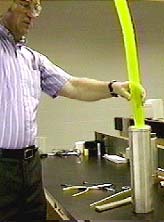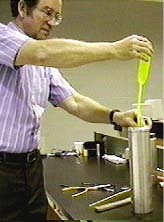Shrinking balloon in liquid nitrogen
 |
 | Applying the ideal gas law to the gas above the liquid nitrogen in a vacuum flask suggests that the volume of a balloon placed in it would reduce to one-fourth its volume. Actually, it reduces much more than that - virtually removing all the gas in the balloon. Why doesn't the ideal gas law apply in this case? |
It is interesting to observe the amount of liquid present inside the balloon once it has been in contact with the liquid nitrogen.
| Go to movie showing shrinking of long balloon |
Temperature concepts
Liquid nitrogen
| HyperPhysics***** Thermodynamics | R Nave |